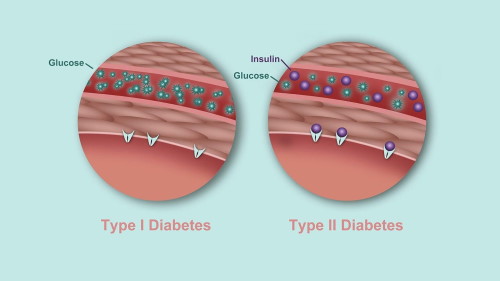How does diabetes affect the body?
There are two main types of diabetes: type 1 and type 2.
Both types of diabetes are chronic diseases that affect the way your body regulates blood sugar, or glucose. Glucose is the fuel that feeds your body’s cells, but to enter your cells it needs a key. Insulin is that key.
BREAKING: Diabetes Breakthrough Leaves Doctors Speechless - Try This Tonight
People with type 1 diabetes don’t produce insulin. You can think of it as not having a key.
People with type 2 diabetes don’t respond to insulin as well as they should and later in the disease often don’t make enough insulin. You can think of it as having a broken key.
Both types of diabetes can lead to chronically high blood sugar levels. That increases the risk of diabetes complications.
What are the symptoms of diabetes?
If not managed, type 1 and type 2 diabetes can lead to symptoms such as:
- urinating frequently
- feeling very thirsty and drinking a lot
- feeling very hungry
- feeling very fatigued
- having blurry vision
- having cuts or sores that don’t heal properly
People with type 1 and type 2 diabetes may also experience irritability, mood changes, and unintentional weight loss.
People with type 1 and type 2 diabetes may also have numbness and tingling in their hands or feet. Good glucose management significantly reduces the risk of developing numbness and tingling in someone with type 1 diabetes, according to the American Diabetes Association (ADA).
Although many of the symptoms of type 1 and type 2 diabetes are similar, they present in very different ways.
Many people with type 2 diabetes won’t have symptoms for many years, and their symptoms often develop slowly over the course of time. Some people with type 2 diabetes have no symptoms at all and don’t discover they have the condition until complications arise.
The symptoms of type 1 diabetes develop quickly, typically over the course of several weeks. Once known as juvenile diabetes, this type usually develops in childhood or adolescence. However, it’s possible to develop type 1 diabetes later in life.
What causes diabetes?
Type 1 and type 2 diabetes may have similar names, but they’re different diseases with unique causes.
Causes of type 1 diabetes
The body’s immune system is responsible for fighting off foreign invaders, such as harmful viruses and bacteria.
In people with type 1 diabetes, the immune system mistakes the body’s own healthy cells for foreign invaders. The immune system attacks and destroys the insulin-producing beta cells in the pancreas. After these beta cells are destroyed, the body is unable to produce insulin.
Researchers don’t know why the immune system sometimes attacks the body’s own cells. It may have something to do with genetic and environmental factors, such as exposure to viruses. Research into autoimmune diseases is ongoing.
Causes of type 2 diabetes
People with type 2 diabetes have insulin resistance. The body still produces insulin, but it’s unable to use it effectively.
Researchers aren’t sure why some people become insulin resistant and others don’t, but several lifestyle factors may contribute, including being inactive and carrying excess weight.
Other genetic and environmental factors may also play a role. When you develop type 2 diabetes, your pancreas will try to compensate by producing more insulin. Because your body is unable to effectively use insulin, glucose will accumulate in your bloodstream.
How common is diabetes?
Type 2 diabetes is much more common than type 1.
According to the Centers for Disease Control and Prevention’s 2020 National Diabetes Statistics Report, 34.2 million people in the United States were living with diagnosed or undiagnosed diabetes in 2018. That’s a little over 1 in 10 people. Ninety to 95 percent of people with diabetes have type 2.
The percentage of people with diabetes increases with age.
About 10.5 percent of the general population has diabetes. Among those 65 years old and older, the rate reaches 26.8 percent. Only 25 out of every 10,000 Americans under 20 years old had been diagnosed with diabetes in 2018.
Men and women get diabetes at roughly the same rate. However, prevalence rates are higher among certain races and ethnicities.
American Indians, Alaskan Natives, and Mexican Americans have the highest prevalence of diabetes among both men and women. In general, Black and Hispanic populations have higher rates of diabetes than non-Hispanic whites or non-Hispanic Asians.
TRENDING: This Keeps Your Blood Sugar Below 100 - Even When You're Eating Sweets!
Prevalence rates are higher for Hispanic Americans of Mexican or Puerto Rican descent than they are for those of Central and South American or Cuban descent.
Among non-Hispanic Asian Americans, people with Asian Indian ancestry have higher rates of diabetes than people with Chinese or Filipino ancestry.









